There Will Be Cake: A Very Detailed Guide to Road-Tripping the Canadian Rockies

This article is part of a series on Canadian food and travel, with support from Destination Canada.
Millions of years ago a few tectonic plates slid into some other tectonic plates and the Canadian Rockies were formed. Because I take slightly more interest in history than I do science, I know that a few centuries later, in the 1880s, the land around them was officially protected by the federal government. Thus, today’s Banff National Park, or as I like to call it, Road-Tripping Heaven, was created.
We all love a good park, but why does a strip of concrete running through an enormous pile of rocks in southwestern Alberta deserve celestial comparisons? Well, just off Highway 1 you’ve got everything you need for an unparalleled Canadian adventure: super dramatic snow-capped mountains; some of the best hiking in the world; a stunning abundance of wildlife; lakes the color of oxidized copper; the coziest of cabins with wood-burning fires; the chance to eat wapiti; the chance to learn what wapiti is (it’s elk); wild mushroom soup so rich with morels it’s almost black; and gin infused with spruce tips.
If that doesn’t sound like heaven I don’t know what does, but perhaps that’s because I’m the embodiment of all my country’s cliches. Still, as a road trip veteran who’s driven between Jasper and Calgary more times than I can count, trust me when I say that this journey through the Canadian Rockies feels no less miraculous the tenth time than it does the first.
Here’s what else I know: Since the classic route through Banff and Jasper National Parks can be certifiably nuts during the summer and fall, it’s best to get off that main road and into the backcountry. There you’ll find an extraordinary combination of landscapes and people, everything from broad grassy meadows and sharply cut valleys to experts in high-altitude baking. You can stand on a glacier and then sip a craft cocktail in the same day, ride a horse through the woods before canoeing across a lake, or hike to a historic backcountry lodge before enjoying dinner by candlelight and the best sleep of your life. With the right gear and a passion for selecting just the right trail mix, these kinds of transformative adventures can be undertaken by anyone.
Keep in mind that summer in the Canadian Rockies runs from July to September. The scenery, however, takes on a particular kind of magic from mid-July to mid-August, when the alpine meadows become carpeted in wildflowers; while this is one of the busiest seasons in Banff National Park, it’s also one of the most ideal times to hike. Autumn’s golden larch trees and cooler temperatures make for a nice (and less crowded) shoulder season, and if you’re after a classic Rockies’ winter, you should plan to travel between December and mid-April.
While the drive from Calgary to Jasper can easily be done in a day, I recommend taking at least a week to travel there and back. That leaves plenty of time to find adventure off the main road, spend some nights in the backcountry, and explore each town along the route. Or maybe go out of your way for a sandwich that you particularly like the sounds of, perhaps the Beef & Cheddar at Cowtown Beef Shack, with pickles, banana peppers, BBQ sauce, and horseradish mayo? (If I were forced to think of an example.)
When it comes to eating, exploring, and slumbering in the best log cabins, here’s a road-tripping itinerary that’ll get you away from the crowds and out among those big rocks. Thanks for the shift, tectonic plates!
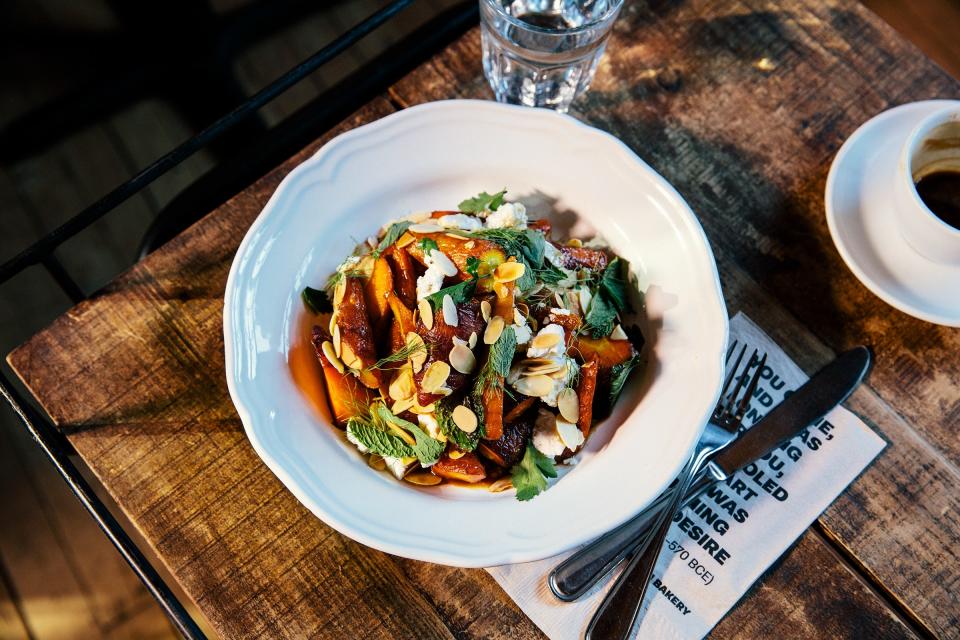
Sidewalk Citizen Bakery in Calgary, Alberta.
CALGARY - DAY 1: Eat, shop, and stock up on snacks in a city nicknamed “Cowtown”
Begin your trip by flying into Calgary, a boom/bust oil city famous for its annual Stampede Rodeo and for being the closest major city to the Canadian Rockies. The airport has a huge rental car center, so reserve ahead of time in order to pick up your car as soon as you land. If you’re traveling in the summer (and plan to drive reasonably on the rougher backcountry roads), a small compact will do you just fine. If you’re arriving in any season with the potential for snow, opt for something with four-wheel drive and proper snow tires.
Once in possession of your adventure mobile, spend the rest of the day in Calgary exploring its burgeoning East Village. At one time practically abandoned, this area is now a bustling and art-filled urban planner’s dream. Stay at the Alt Hotel (635 Confluence Way SE, Calgary, AB) and get all of your breakfast, lunch, snack, and coffee needs across the street at the Simmons (618 Confluence Way SE, Calgary, AB) , a former mattress factory turned food hub. The bureka plate from universally adored Sidewalk Citizen (618 Confluence Way SE, Calgary, AB) is an ideal breakfast—the sesame-topped, feta-filled pastry is stuffed with a fried egg and served with a lemony cucumber and tomato salad, a hefty spoonful of hummus, and the housemade green or red harissa (I always opt for green). Or, venture southwest to try their newest outpost on Central Memorial Park (340 13 Ave. SW, Calgary, AB) which is also open for dinner; the veg-focused menu includes plates like vegan spiced mushroom shawarma and barramundi ceviche with chile, preserved lemon, and tumeric.

The restaurant Pigeonhole in Calgary, Alberta.
For dinner, reserve a table at the long and skinny Bar Von der Fels (1005A 1 St. SW, Calgary, AB) for its seasonally refreshed small plates. The menu includes things like hasselback nugget potatoes (can you imagine the prep!) topped with sweet Fogo Island crab and nutty spoonfuls of brown butter. The Bread & Fresh Cheese option is actually pull-apart buns, and since there are few things in life better than their salty, butter-brushed golden tops, be sure to get an order.
Speaking of cheesy carbs, down the street and around the corner is Pigeonhole (306 17th Ave. SW, Calgary, AB), a place known for its refined comfort food and pleasing brick and wallpapered interior. The aged-cheddar gougères—which I believe to be about 70 percent cheese—are so good you may want a second order to go. Out in the non-food realm, Mission’s serene Fieldstudy shop (102 - 1812 4 St. SW, Calgary, AB) is worth a browse for the linen jumpsuits, Guatemalan hats, and ceramics alone, while Esker Gallery (1011 Ninth Ave. SE 4th floor, Calgary, AB) in Inglewood is both exceptionally well-curated and free to the public.
Finally: If, like me, you have a general fear of growing hungry without readily available snacks, especially while in a car, I’d suggest stocking up on supplies before leaving Calgary. Community Natural Foods (1304 10th Ave. SW, Calgary, AB) is a well-stocked local institution, and the perfect place to build your hanger-prevention kit of trail mix, fresh and dried fruit, granola bars, kombucha, and whatever else you fancy from the bulk section.
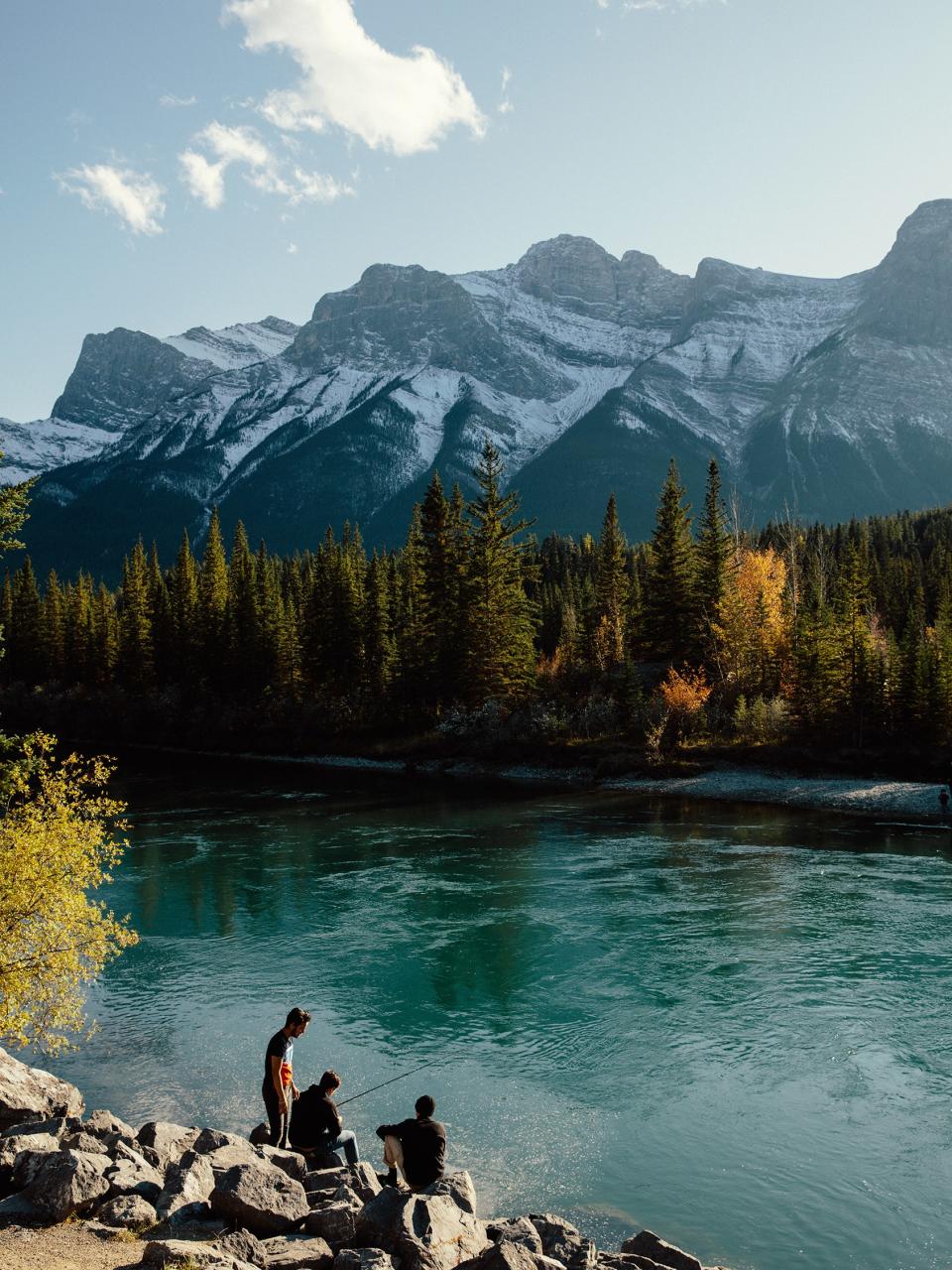
CANMORE - DAY 2: See how they do afternoon tea Rockies style
Finally, we’re ready to head west for what you really came for: the mountains. Begin the journey by driving to Canmore, a town so built on outdoor adventure that there are truck taxis hauling mountain bikes around. If you’d like to get in on all that action and also happen to love cake, here’s the perfect day: Getting an early start, drive down the unpaved but well-used Smith Dorrien Trail and hike either the heart-pumping Tent Ridge loop or more moderate Rummel Lake route. (Take note that on Smith Dorrien Trail—and most roads here, paved or not—there’s a good chance you’ll come across animals. Always be sure to drive with caution, especially around mountainous bends, and give the animals plenty of space as they make their way back into the landscape.)
For this (and any other) hike in the Rockies, necessities include plenty of water (a hydration reservoir for your backpack is one of the smartest investments you can make), snacks, multiple layers in case of temperature changes, a rain jacket, a small first aid kit, blister supplies, and a hat. Bear spray is also a good idea, but be sure the store gives you thorough instructions on how to use it (in other words, don’t accidentally mace your friends, ’k?).
After your hike, head to nearby Mount Engadine Lodge (1 Mount Shark Rd., Canmore, AB) for a Rockies-style afternoon tea. It offers charcuterie boards, cake, tea, coffee, beer, and wine from 2–5 p.m., all of which are best consumed on the massive wooden deck; if you’re lucky, you’ll spot a moose in the sprawling meadow below. If you’re a winter visitor, swap out the hike for a snowshoe trek along the Chester Lake Trail.
For dinner in Canmore, Where the Buffalo Roam Saloon (626 Main St. #2, Canmore, AB) is an intimate candlelit bar and restaurant popular with locals. Order a few of the shared plates, like the warm chimichurri potato salad and satisfyingly classic Scotch egg. At the end of the day, rest your head at the lovely Paintbox Lodge (629 10th St., Canmore, AB). This friendly little inn is owned by Olympic and World Cup Champion skiers Sara Renner and Thomas Grandi, both of whom know the Canmore area inside and out.
A worthwhile aside: Renner and Grandi also run Talus Lodge, a remote backcountry retreat where I once spent three rather life-changing days. Yes, it’s a bit of a splurge—guests arrive via a 15-minute helicopter ride from Canmore—but staying in an off-grid lodge at 7545 feet is an otherworldly experience. Talus sits atop a rocky plateau surrounded by turquoise lakes, meadows, waterfalls, and a series of impressively tall peaks. We hiked with a skilled guide all over this extraordinary landscape, and I took to plunging into a different body of glacial water each day. Late afternoons were spent reading one-handed (the other was forever extended toward slices of smoked bison on the charcuterie plate) or in repose inside the wood-fueled sauna. For dinner, dishes like braised chicken, creamy herbed polenta, fresh sourdough, and salad with foraged glacier lilies were laid out, followed by pots of Earl Grey panna cotta topped with stewed blueberries for dessert. Full and content, I’d set my alarm before falling asleep; that way I could sneak out at midnight to see the Milky Way which, far from any light pollution, burned so intensely bright that I (may have) cried. While the summer hikes can be adjusted to suit any level, I’d recommend booking only for the winter if you’re a confident backcountry skier. If you can swing it on this trip or another, it’s a profoundly special place.

BANFF - DAY 3: (Safely) scale a mountain, then go back in time
The next morning, stop into Le Fournil (101-1205 Bow Valley Trail, Canmore, AB) for seriously good French pastries or baguettes with ham and butter, then head west toward Banff and up to Mount Norquay for the Via Ferrata. Italian for “iron path,” Via Ferrata is a protected climbing route that sees participants scaling mountain sides that would otherwise be impossible for non-climbers to reach. Once harnessed and briefed for safety, you’ll ride on the chairlift (a great perch to spot bears) before maneuvering yourself up, up, and up the sides of Norquay’s limestone cliffs. If that last sentence caused sweat to form on your upper lip, don’t worry—as long as you’re capable of climbing a ladder and don’t possess a completely crippling fear of heights, you’re set. (I, for example, have but a mildly disabling fear of heights, and with a few deep breaths I was fine). Also, the equipment was designed so that even the backups have backups, so the only thing likely to fall is your phone (which apparently happens on the regs, so keep that thing zipped). As well as offering a nice workout, the Via Ferrata will provide you with some of the most surreal views of your whole trip.
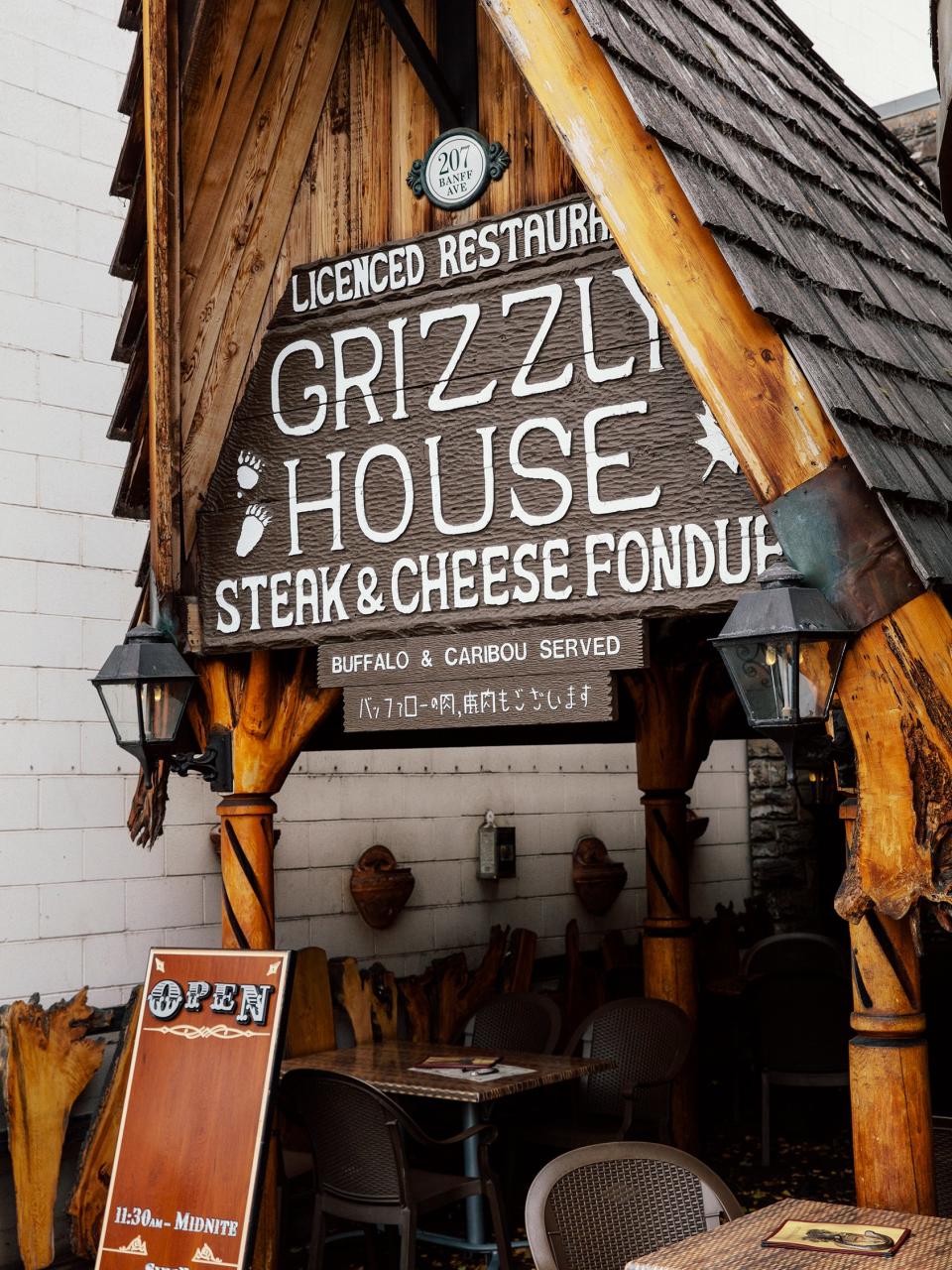
Once back on solid ground, experience time travel by having dinner at Banff’s the Grizzly House (207 Banff Ave, Banff, AB). This “place for hedonists” is a truly vintage den that’s changed little since opening in 1967. Think endless wood panelling! Macrame! Mounted animal heads leering over you while you eat! And best of all, old-school brown phones about the size of a boot at each table, left over from the restaurant’s “swingers’ disco” era. (True story, and they still work. There are instructions for calling other tables posted in the ladies’ washrooms). The eccentric hand-drawn placemats are good entertainment while you wait for your food, and the fondue-themed menu is built for carnivores; it features everything from Alberta beef and wild boar to “exotic” meats such as rattlesnake. I highly recommend ordering the “sow” (that’s a mother bear for all you backcountry newbies) portion of the hot rock fondue Bourguignonne, with beef instead of chicken. This is no time for chicken. Seared in garlic butter until medium-rare (by you, mama bear), the cubes of beef end up so tender and packed with flavor that you can ignore the “special sauces” they’re served with. The scoop of pickled bean salad, fried potato rosti, green salad, and curly kale garnish are welcome additions, however. After all, this is 1967.
The Grizzly House is popular, so make a reservation, and do not wear your favorite clothes. They’re guaranteed to smell like fried meat (perhaps even rattlesnake?) for far too long afterward. And on the glamorous subject of parking: Since Banff’s town core can be a bit of a zoo, park in one of the quieter surrounding neighbourhoods, then walk into the center. It takes only five to 10 minutes on foot.
For your third and fourth nights, book ahead to stay at Storm Mountain Lodge (Highway 93 S., Banff National Park, AB), a small and idyllic resort in between Banff and Lake Louise, just off the highway. Built in 1922, the impeccably maintained log cabins put anything else filed under #cabinporn to shame; each one has its original wood-burning fireplace equipped with plenty of chopped wood, kindling, and matches to get you started. As for Storm’s exquisite main lodge, it doesn’t appear to have changed much since the ’20s either. There’s a restaurant; a tiny but perfect bar; a gift shop with an impressive collection of Canadian lit (your chance to discover Richard Wagamese!), and a crackling wood fire that’s fed morning ’til night.
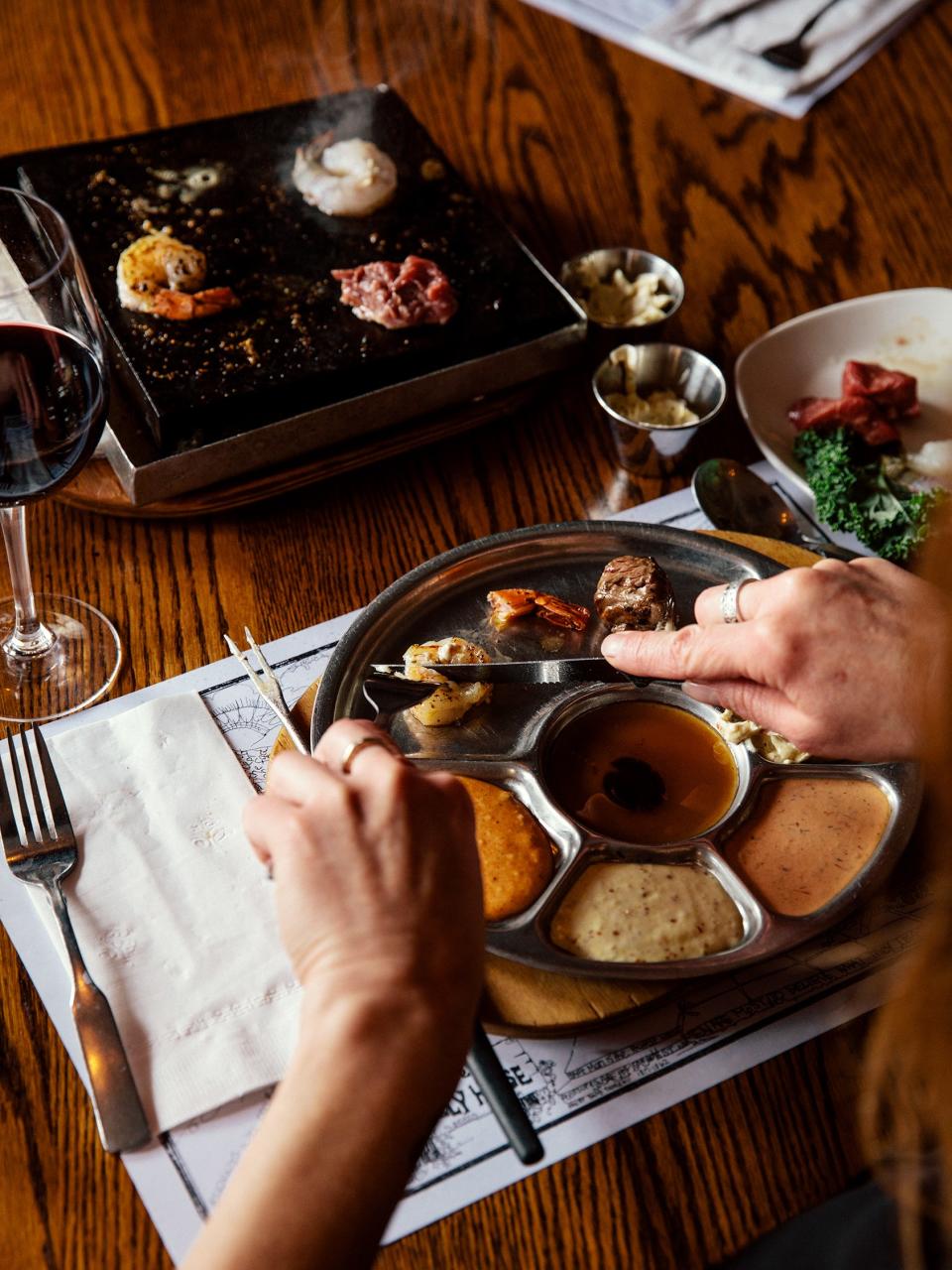
LAKE LOUISE - DAY 4: Get up early and earn your (lakeside) breakfast
Your next major stop is Lake Louise, a world-renowned site that’s busy beyond belief for most of the year. Let me be straight: While Lake Louise is stunning, there are too many pretty lakes in this region to be crowded around just one. The better plan is to go up to the Lake Agnes Tea House for breakfast, a trek involving all the things we like: hiking, waterfalls, lakes, and baked goods. Here’s how to do it: Depart Storm Lodge by 6:25 a.m. in order to arrive at Lake Louise by 6:45 a.m., and nab a coveted parking spot in the lot (which will already be three-quarters full). Once hiking-ready, say good morning to Lake Louise (she’s lovely) as you pass by the imposing Fairmont Chateau, following signs for Lake Agnes Tea House.
It’s a sometimes steep 4.5-mile trail to the top, but this quiet, crowdless morning journey is worth it. Founded in 1905 as a refuge for hikers (and still only accessed on foot or by horse), Lake Agnes’ first teahouse was replaced 38 years ago by the current one, which still features the original windows, tables, and chairs. Upon arrival, grab a seat overlooking the lake and enjoy your breakfast of tea and warm buttered biscuits with jam, or perhaps some soup and hearty oatmeal brown bread. Considering that supplies are hiked up each week by staff and their food is prepared from scratch, the menu is surprisingly extensive. Be sure to pack out any garbage you’ve brought up so as not to burden them further, and remember to bring cash. They accept both Canadian and American currencies and deserve a nice fat tip. Post-breakfast, if your legs will allow it, follow the trail to the far side of Lake Agnes, then amble up a series of switchbacks to the top of “Big Beehive.” Yes, it’s more elevation, but this bulbous hunk of rock offers a remarkable view of three different lakes below.
If you’re visiting after Lake Agnes has closed for the season (it’s open from June until Canadian Thanksgiving, which falls on the second Monday of October), opt for Johnston Canyon on the Bow Valley Parkway instead. The trail there is open year-round and is especially jaw-dropping once its waterfalls have frozen into sculptural walls of ice. Because the trail offers huge rewards for relatively little effort, it can become overwhelmingly crowded in the summer; during the rest of the seasons it’s calmer, but, as is my tendency, I still recommend arriving super early to have the place (almost) to yourself.
SKOKI LODGE - DAY 5 & 6: In which all your backcountry food and lodge dreams come true
The region around Lake Louise also houses the backcountry wonder that is Skoki Lodge (1 Whitehorn Dr, Lake Louise, AB), a destination that’s best booked a year in advance and requires a two-night minimum stay. Its first big sell? The axe-hewn spruce lodge that was built in the 1930s and is about as handsomely rustic as lodges come. Even though it operates without electricity or running water, Skoki is immaculately clean and beyond comfortable, with truly perfect cushioned daybeds extending from each window (this lodge is the architectural equivalent of being wrapped in a warm blanket). It’s reached on foot from spring to fall, with the seven-mile trek over Deception Pass taking hikers alongside lakes, between impossibly large boulders, and through valleys veined with creeks; if the weather is right, the view from the top of the pass is particularly striking. It’s also possible to ride in on horseback with Timberline Tours Ltd., and during Skoki’s winter season, access is by skis or snowshoes.
Its next major sell? From the off-the-grid kitchen, cooks like Vanessa Stirrett prepare some of the best food you’ll eat in the Rockies. Like Engadine, Skoki puts on an impressive afternoon tea, followed by much-anticipated feasts for dinner. Guests commune around the long wooden tables, illuminated only by candlelight and oil lamps once the sun has set. The cooks prepare dishes that are seasonal and restoring, like rack of lamb; roast carrots with tahini sauce; buttered green beans and pink radishes; herb-y potatoes; tzatziki that zings with garlic; and fluffy white buns baked in cast-iron pans. After, there are desserts like mascarpone-frosted honey cake to enjoy before burrowing below the wool blankets of your bed. Tired from hiking and full from dinner, 10 bucks says you’ll be asleep by 9 p.m.
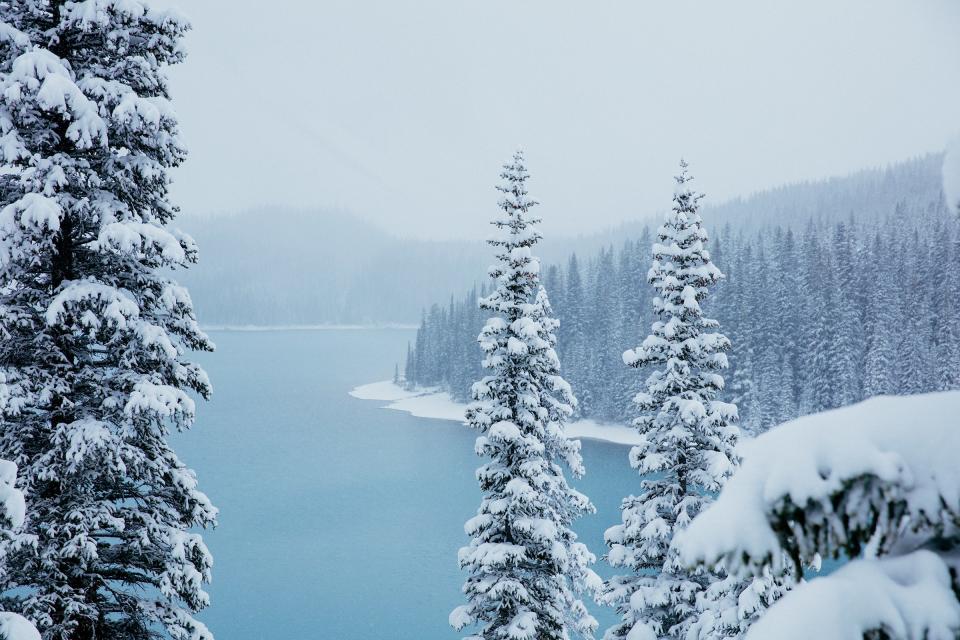
The next morning you’ll arise to a large breakfast of both sweet and savory dishes (including some fiercely good pecan-heavy granola), then pack your lunch from the spread of meats, cheeses, homemade molasses brown bread, vegetables, fruit, trail mix, and cookies. Then it’s off for another hike—the trek to Merlin Lake makes for a good adventure (and allows plenty of time to come back and read before tea), but the knowledgeable Skoki managers can offer many other options as well.
Skoki’s final major sell? It’s so idyllic, Kate and William chose it for their few days off during the 2011 royal tour of Canada. (Very down to earth of them, no?)
On your hike out from the lodge, I strongly recommend taking Packers Pass, the alternate route to the one you came in on. Packers first takes you through a verdant and picturesque valley, then sees you climb (with surprising ease!) up the side of a waterfall. With this trail and others, it’s important to remember that if the landscape becomes rocky and the trail disappears, just follow the cairns (small human-made stacks of rocks acting as trail markers) until the path reveals itself once again.
Once you’ve emerged from Skoki and are back on the main highway, make sure everyone in the car is awake for the views north of Peyto Lake. Here the mountains unfold so darn majestically, you might find yourself shouting in disbelief to no one in particular. These vistas are even more mind-bending at golden hour, so aim to pass through in the early evening if you can.
JASPER - DAY 7 & 8: Ride a horse, paddle a canoe, and drink an iconic Canadian cocktail
Jasper—your next and last major stop—is a quaint, laid-back town that’s popular with tourists but far less busy than Banff. While the hiking at Jasper National Park is great, it’s also an ideal place to venture out on the water or by horseback. Maligne Lake is the most famous in the area, but you can avoid the masses by heading to Pyramid Lake instead. It’s beautiful, less busy, and has some of the most reasonably priced canoe and kayak rentals in the area. The staff recommend arriving right when it opens at 9 a.m. when the lake is glassy calm and nearly empty.
To explore the landscape in the most Albertan of ways—by horseback—book in for a trail ride with Mary Luger at Old Entrance (26118 Old Entrance Rd., Hinton, AB). Mary has operated her stables here, about an hour north of Jasper, for over two decades, all on the same 60 acres her grandparents homesteaded in 1913. She takes groups out riding several times a day on her large and impressive horses, first along the steely Athabasca River and then up into the hills. Mary is a quiet but friendly host, as is Sargeant, a smiling old Lab who follows her everywhere. To book a trail ride, reserve with Mary by email at least a few days in advance.
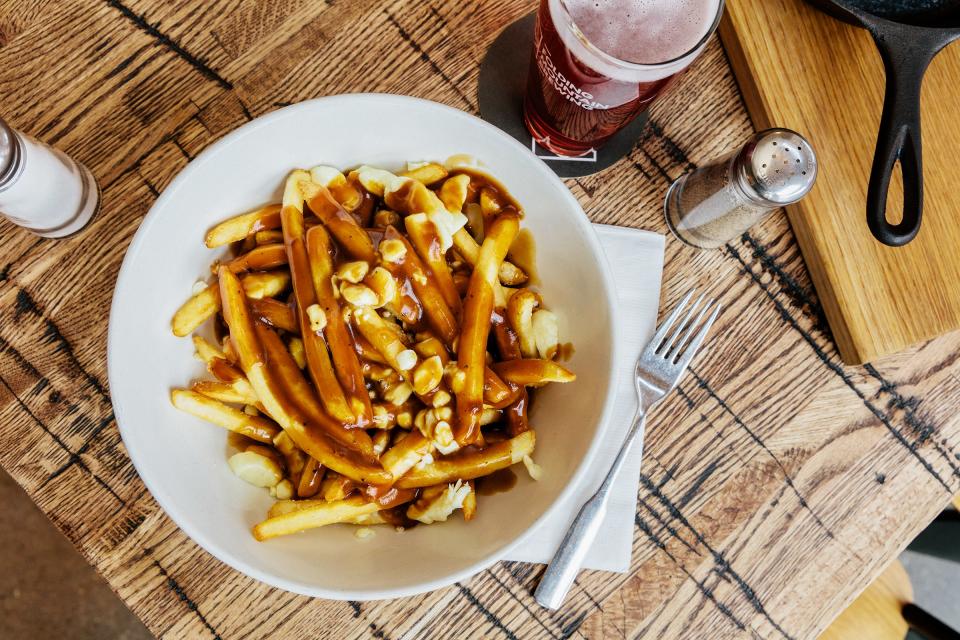
Folding Mountain Brewery near Hinton, Alberta.
Another worthy stop is the Fairmont Jasper Park Lodge (1 Old Lodge Rd., Jasper, AB). Although this iconic resort’s origins date back to 1915, its enormous main lodge was constructed in the 1950s and still maintains its midcentury charm. While I wouldn’t necessarily endorse the cost of spending the night here, I definitely urge you to pass some late afternoon hours in the Emerald Lounge, which sits next to a towering wall of windows overlooking the mountains and a lake. The Canadian thing to do is order the Mountain Caesar, a Bloody Mary–adjacent cocktail not to be confused with the salad, which arrives with a hefty garnish of pickled vegetables and beef jerky. (In case you should find yourself at a Canadian trivia night, Caesars were invented in Calgary in 1969 and are differentiated from the more ubiquitous Bloody by the inclusion of Clamato, a mixture of tomato and clam juices that is to be embraced, not feared). Once your drink has arrived, snag a seat near the lodge’s comically large fireplace and revel in a space that’s hosted a king, a queen, and Marilyn Monroe.
For easy access to town, horseback riding, and good beer, Jasper East Cabins (49321 Highway 16, Jasper East, AB) is a convenient (and relatively affordable) place to stay in this region. It’s located 30 minutes north of town, placing you halfway between Jasper and Old Entrance, as well as within five minutes by foot to Folding Mountain Brewery (49321 Highway 16, Jasper East, AB). It’s nice to end the day with a pint of the alpine cranberry sour and a bowl of poutine generous in both gravy and curds.
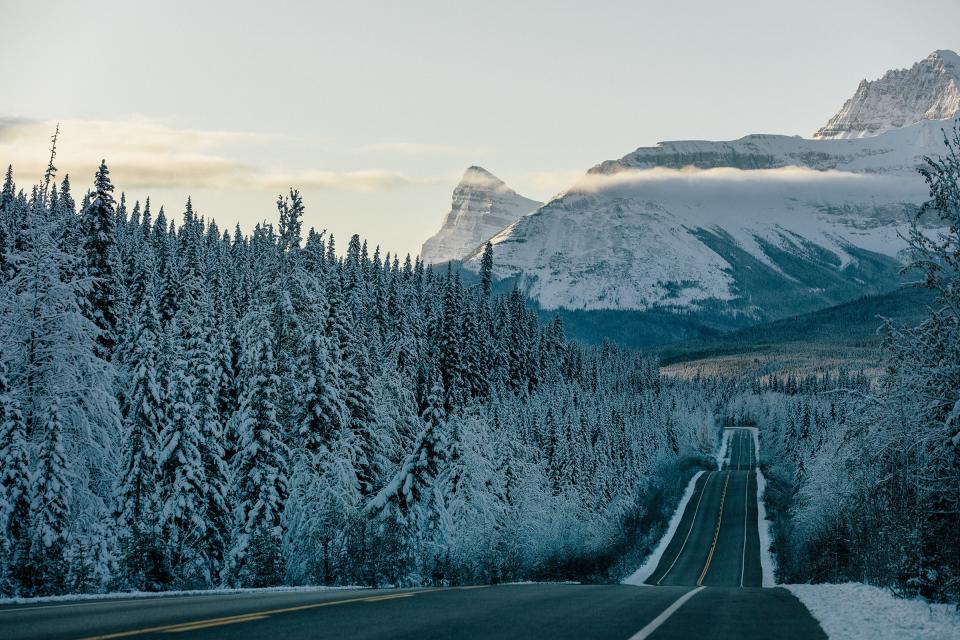
Icefield Parkway views.
JASPER BACK TO CALGARY - DAY 9: Stand on an icy glacier before your drive back to real life
Since Jasper is as far north as you’ll go, your final day will see you driving the four and a half hours back to Calgary. Break up the trip by stopping at the Columbia Icefields and admiring the Athabasca Glacier, a constantly evolving mass of ice that at points stands nearly 1,000 feet thick. There are two options for seeing it: First, the Icefield Discovery Centre (Highway 93, Icefields Pkwy, Improvement District No. 12, AB) offers tours in its gargantuan Ice Explorer trucks (they weigh 55,000 pounds). These drive right up onto a designated area of the ice, meaning guests can get out and walk around the actual glacier; I’d opt out of the additional “Skywalk” option, however, since you can get better views for free elsewhere. Alternately, you can drive your own car to the glacier’s base to enjoy the view for free and with less company. If opting for the latter, please heed the warning signs and stay off the ice itself. Plenty of visitors ignore them, not realizing that crevasses and glacial features called millwells could eat them up.
Alternately, if your muscles are mad about all the steep trails you’ve forced them up, treat them to a few hours of hydrotherapy at the Kananaskis Nordic Spa (1 Centennial Dr, Kananaskis, AB). About an hour southwest of Calgary and open year-round, this site offers a circuit of hot and cold pools; saunas; steam rooms flush with essential oils; hammocks for resting and reading; wood-burning fire cauldrons; massages; and even a bistro for you to stumble into half drunk on relaxation. (Haven’t we all been waiting for a restaurant where the dress code is “plush robe” and you get to eat while lying on a couch?) I suggest ordering the colorful and vegetable-heavy Refuel Bowl for your health, the warm grilled artichoke and caramelized onion dip for your soul, and a glass of bright BC-produced Joie Rosé for whoever’s not driving. Despite its relatively remote location, Kananaskis Nordic Spa is a popular place, so call ahead to ask about the wait times. Hot tip: If you book a massage, you’re guaranteed access to the spa pools. For the sake of efficiency, you can’t afford not to get one.
If you need a lunch break before Kananaskis, stop at Park Distillery in Banff, one of the only distillery/restaurants within a national park. Hung from the ceiling, red camping lanterns illuminate the room, and gleaming distilling tanks can be seen through a wall of glass. I like to grab a spot by the bar and order the Blu Dog (a house-made corn dog with mildly sweet and super tangy blueberry ketchup for dipping) or the saucy rotisserie chicken sandwich with granola-topped greens. If you’re interested, Park offers free tours every day at 3:30 p.m., but they always fill up quickly so be sure to reserve your spot. After, I recommend popping into the pint-size retail shop to buy a bottle of Park Alpine Gin. It counts foraged spruce tips among its botanicals, making for a particularly Canadian G&T—and a souvenir you can enjoy long after you return your rental car.
Want more on Canada? Right this way!
Originally Appeared on Bon Appétit

